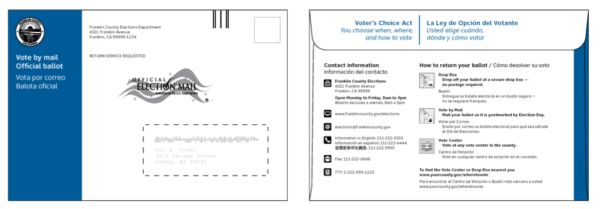Helping vote-by-mail ballots make their way to the voter and back again
For a vote-by-mail ballot to be cast and counted, it has to make its way to the voter and then back to the election office safely. With millions of ballots traveling through the US Postal System each election, some go astray.
Voters don’t recognize that the ballot they received is their official ballot, not a sample to review before voting or even campaign literature. (And vice versa!)
Postal automation equipment can deliver marked ballots back to the voter instead of the election office. Or they can end up in a stack going to the wrong office.
The envelope design is key to making sure that ballots make the round trip successfully, so election officials can accept and count them.
Voting by mail has some extra challenges beyond knowing how to mark the ballot to reflect their choices.
- Voters have to find the ballots in their mailbox, delivered there accurately and on time.
- They also have to understand – recognize – that this envelope is their ballot, not just any other piece of mail that arrives. And they have to understand their options for returning the ballot.
- Finally, they have to use the envelope to return their ballot, packing it up and signing, and then returning it back to the elections office in time to be counted.
When all of the visual and information elements come together, it not only works for voters, but also helps the US Postal Service and the elections office do their part more easily.
A simple, clear design makes the official ballot envelope stand out
The first step in the design is to make sure the ballot doesn’t land in the trash with other junk mail, or get lost among the bills on the kitchen table. Through 2017 and 2018, we worked with election officials and the USPS to devise new designs to solve the typical issues of voting by mail We wanted the envelopes to look attractive, but not like an advertisement.

The front and back of the envelopes for vote-by-mail packages headed to voters. The icons on the back of the envelope are from the Civic icons and images library on ElectionTools.org
The front of the envelope features the county seal along with the election mail logo.
- Every envelope that holds a ballot uses the same general layout and visual design, so they are all recognizable as part of voting by mail.
- There is as little text in as possible on the front of the envelope so that the message that an official ballot is inside can be in a font large enough to read easily. The minimal text also leaves room for a second language for counties that have bilingual ballots.
- The back of the envelope has information about how to return the ballot and contact information for the election office.
The visual design elements are more than just decoration
All of the envelopes have a band of color on the left side of the envelope. The color is a code that helps everyone handle the ballot appropriately.
In our design, blue envelopes go to the voter. All other colors are headed back to the election office. It’s an easy rule for the postal team, so they know at a glance which direction a ballot is heading in.
There’s more than one option for the color on the return envelopes so that neighboring counties can coordinate and use distinctive colors, or envelopes for overlapping elections (like special elections) can be kept separate.
Because the color wraps around the edge of the envelope, its visible even in a big stack, like the pallets of mail in a postal sorting facility. Even one envelope in the wrong color is easy to spot.
The back of envelope supports accurate packing and processing
- For the voter, there’s a checklist, right where they can see it when they are packing and sealing the envelope.
- For people working in the election office, the county and election are identified on the back, so they can make sure the envelope is in the right place before it is opened.
- Critical information that helps sort and handle the ballot can be pre-printed, saving everyone time by making it easy to read and check.
X marks the spot for the voter’s signature

The signature form can be filled in by hand or printed with the voter information for their signature. The two holes act as a guide for blind and low-vision voters so they can sign independently.
The voter declaration and signature form follow best practices, too.
- The instructions speak directly to the voter saying “Sign here” with a reminder that their signature must match the one in their voter registration file.
- The location for the signature is marked with a large “X.” Boundary lines around the signature box make it stand out – and serves as a subtle guide so any automation works better.
Consistency across counties helps with voter education
There’s one more hidden feature: the opportunity for uniformity. In most states, each county designs its own envelopes, so they all look different.
This makes it hard to do statewide voter education campaigns to help voters recognize their ballots, or show them how vote by mail.
Oh, and all that variation is harder for the Postal Service, too.
Resources
Field Guide Vol. 10 Creating forms that help voters take action

